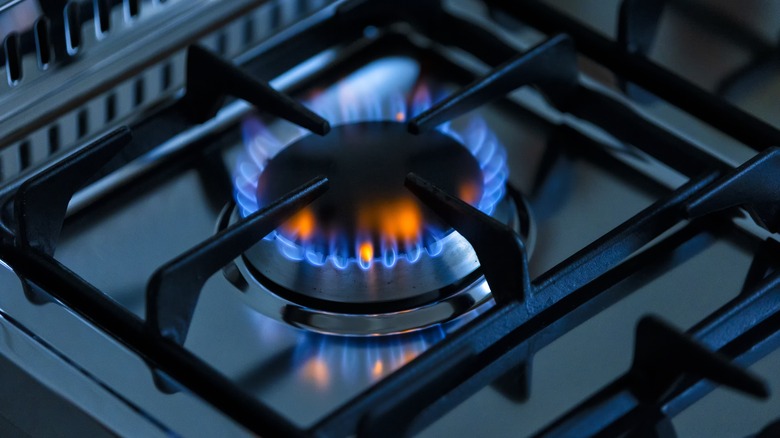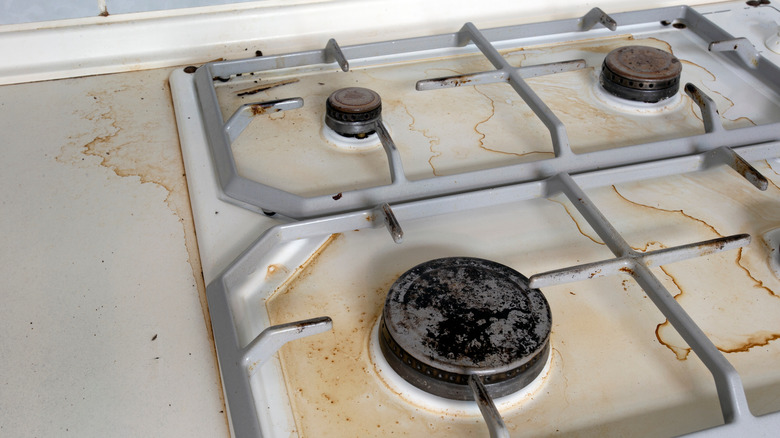What To Know About Converting A Gas Stove To Propane (& Should You Hire A Pro?)
So, you've bought a natural gas stove, and you want to convert it to propane. You've made a wise choice, financially speaking. Buying propane by the tank gives you the flexibility to watch prices and buy when it's convenient and cheapest. You might even buy spares when they're cheap (but remember that it's not safe to store them in your garage!). You might have some misgivings about the conversion process since, like almost all homeowners, you have a natural aversion to blowing up your house. But take heart: This is usually not a difficult process, and you're unlikely to blow anything up or burn anything down. For most stoves, it's the sort of task you can perform in an hour or so with common tools. For other stoves, it's definitely the sort of thing you'll want to hire a pro for.
A natural gas stove will technically burn propane with no conversion at all, but the first time you try it is likely to be your last. Propane is delivered at a higher pressure than natural gas, and thus requires much smaller gas orifices and a few other tweaks to safely dispense the gas. The YouTube channel Ben's Appliances and Junk has a great video about the conversion process that shows what happens when you use propane without the conversion, and it's positively terrifying ... something like trying to heat a tea kettle on a bonfire. We're against it, and you should be too. Better to get the conversion done.
Converting a newer stove to propane
If you've bought a new or used stove or recent vintage, there's a chance that everything you need for the conversion is already right in front of you, and it's simple enough to DIY if you're comfortable with it. In most cases, new stoves come with replacement orifices, packaged with documents like a wiring diagram and attached to either the back of the stove or behind the stove's warming drawer. These little brass nozzles look like nothing so much as 3D printer nozzles, and are replaced as easily; you'll unscrew (with a properly sized wrench, please, not pliers) the old orifices and screw in the new ones for your stove's range burners. The other necessary adjustments can be made with no additional parts at all. It varies by model, but for most you'll need to remove, flip, and reinstall the conversion plug in the stove's pressure regulator. Then, tighten the orifice spuds for the bake and broil burners according to manufacturer recommendations. Finally, fully open the air shutter for both the bake and broil burners.
If your newer stove doesn't happen to have a conversion kit attached, you should be able to track one down with little difficulty. There are slightly different designs and they're calibrated for the particular BTU rating of your range, so this isn't a good time for guesswork. Contact the manufacturer and get the right replacement orifices, or guidance on where to find a safe third-party kit.
Converting an older stove to propane
Things get a bit trickier with vintage stoves. There's a whole community growing up around vintage kitchen appliances, and there are a lot of vintage stoves around because they were very well-built. But they were also built for natural gas, and conversion kits aren't readily available for some older stoves, but there are a couple of approaches you can take. Try contacting the manufacturer... if the manufacturer still exists (many, including prominent stove manufacturers like Wedgewood, have been consolidated over the years). For these vintage stoves, try contacting an appliance repair shop or an online resource that specializes in older appliances.
One final route available to you is to have your existing natural gas orifices physically altered to work with propane. It might sound slightly mad, but remember that machines — especially home appliances –– were far simpler in the past, and gas stoves have remained pretty simple all along. So all that's usually required is silver-soldering the gas port closed, then re-drilling the orifice at the proper size for propane using an increasingly smaller series of drill bits. The soldering is a bit of a specialty, and you can probably get it done at a jeweler or a machine shop. The machine shop should also be able to handle the drilling, though you can certainly manage it at home with a little care and a set of good bits. Compared to the overall cost of installing a gas stove, these expenses should be comparatively minor.

